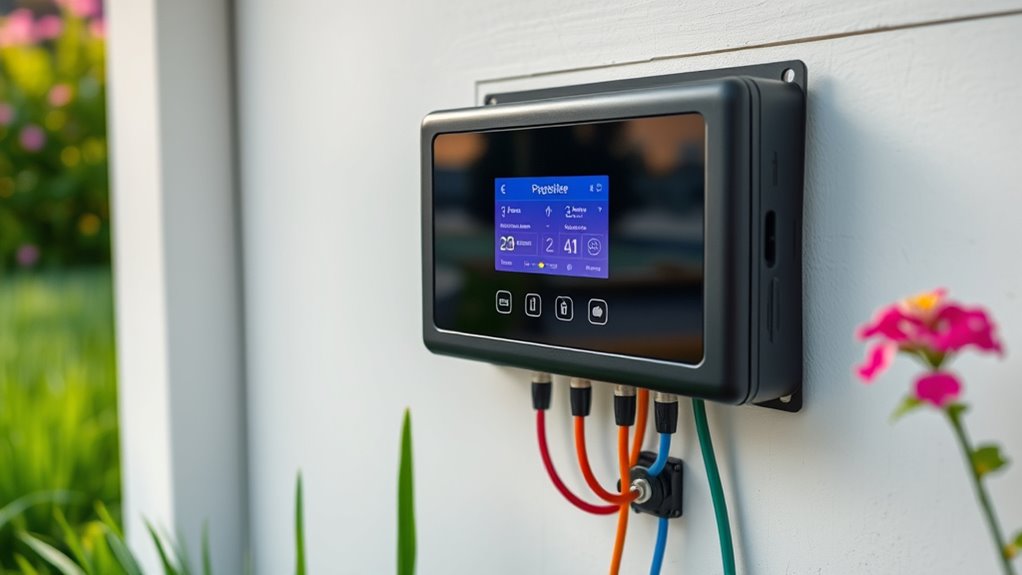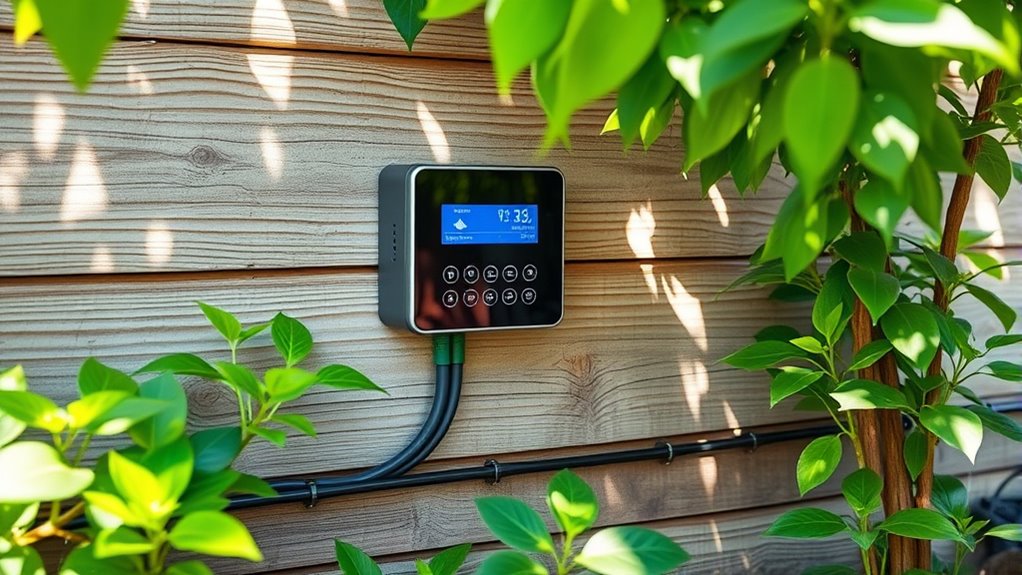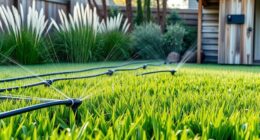Setting up a smart irrigation controller is straightforward: connect it to your WiFi, link it to your existing systems, and configure the app or touchscreen based on your zone needs. These controllers automatically adjust watering times using weather forecasts, helping you save water and lower bills. They support multiple zones and sensors for real-time control. Want to discover simple tips for installation and maximizing savings? Keep exploring to get the most benefits from your system.
Key Takeaways
- Setup typically involves connecting the controller to WiFi, scheduling via a mobile app, and integrating sensors if available.
- Proper configuration ensures optimal watering based on weather forecasts, soil moisture, and environmental factors.
- Smart controllers reduce water waste, leading to lower water bills and energy costs over time.
- They support multiple zones, enabling customized watering schedules for different areas.
- Investing in a smart irrigation system offers long-term savings and environmental benefits through efficient water use.

Are you looking for an efficient way to water your lawn and garden while conserving water and reducing costs? Smart irrigation controllers are the perfect solution. These devices automatically adjust watering schedules based on weather forecasts, soil conditions, and other environmental factors, ensuring your landscape gets the right amount of water without waste. To get started, you’ll need an internet connection, as most smart controllers rely on WiFi to sync with weather data and allow remote management through mobile apps. Many models, like the Rachio 3, let you select specific local weather stations or use averaged weather data for more accurate adjustments. You might also want to add sensors for soil moisture and flow monitoring, which some controllers support, to further refine watering based on real-time conditions. Smart irrigation controllers support automated management, making landscape watering more efficient. Setup typically involves connecting your controller to your existing irrigation system and configuring it via a user-friendly app or touchscreen interface. For example, the Smart Rain SmartController offers an intuitive touchscreen, making setup straightforward. Keep in mind that some models, like the Rain Bird ST8, come with WiFi modules and manual controls, providing flexibility if you prefer a mix of automation and manual adjustment. Many controllers also support multiple zones—up to 16 in some cases—so you can manage different areas of your yard independently. Additionally, certain models, such as Orbit BHyve, include features like wind and soil saturation calculations and support external flow controllers, enhancing water efficiency and leak detection. Cost is an important consideration. While smart controllers tend to be pricier upfront than traditional systems, they offer significant savings over time. They help reduce water waste by adjusting schedules based on weather, which can lead to lower water bills. Plus, optimized watering schedules can decrease energy consumption for pumps and other equipment, further trimming your costs. During droughts or water restrictions, these controllers are invaluable—they automatically modify watering routines to comply with regulations, preventing fines and conserving precious resources. The long-term savings from reduced water and energy use, along with the improved health of your landscape, make smart controllers a smart investment. Brands like Rachio, Rain Bird, Smart Rain, Hydro-Rain, and Orbit BHyve offer a variety of models suited for different property sizes and needs. Rachio is known for its responsive weather features and app control, while Rain Bird offers both traditional and expandable smart options. Many of these systems support voice commands through smart home assistants like Alexa and Google Home, adding convenience. By choosing a smart irrigation controller, you not only streamline your watering but also contribute positively to environmental conservation efforts. They reduce water waste, support drought management, and lower energy consumption—making your garden greener and your wallet happier.
Frequently Asked Questions
How Do Smart Controllers Adapt to Unexpected Weather Changes?
You might wonder how smart controllers handle unexpected weather changes. They constantly monitor real-time weather data, like sudden rain or temperature shifts, using weather data integration and soil moisture sensors. When unexpected rain occurs, the system suspends watering automatically. If a heatwave strikes, it adjusts the schedule to provide more water. These features guarantee your landscape receives ideal care without manual intervention, saving water and maintaining healthy plants.
Are Smart Irrigation Controllers Compatible With Existing Sprinkler Systems?
You might worry about compatibility, but most smart irrigation controllers are designed to work seamlessly with your existing sprinkler system. They require minimal modifications, often just connecting to your current pipes, valves, and sprinklers. No digging or major upgrades needed. Plus, many models support various zone configurations and integrate with your smart home devices, making installation straightforward and ensuring your system adapts effortlessly to your current setup.
What Is the Typical Installation Process for Smart Controllers?
You start by testing your current system to guarantee all zones work properly and take photos of wiring for reference. Turn off the power before removing the old controller and mount the new one securely, making sure it’s level. Label and connect the wires correctly, then power up and check for errors. Finally, download the app, connect to Wi-Fi, and configure your zones and schedules for ideal watering.
How Can I Monitor Water Savings Over Time?
Monitoring your water savings over time is like watching a garden flourish—patience reveals growth. You can do this by installing water meters specifically for your irrigation system, then regularly reviewing data on water usage. Comparing this data with historical records or industry benchmarks helps you see progress. Adjust your schedules based on real-time weather and soil moisture info, and analyze trends to maximize savings and guarantee your system keeps performing at its best.
Do Smart Controllers Require Professional Setup or Can I Install Them Myself?
You can definitely install smart controllers yourself. Most are designed for DIY installation, taking less than 30 minutes, with clear app guidance and simple tools like screwdrivers and drills. Just guarantee you carefully follow instructions, especially wiring, and take photos of your old setup before disconnecting. With some basic technical skills and patience, you’ll have your smart irrigation system up and running without needing professional help.
Conclusion
Embracing a smart irrigation controller is like planting a seed for a greener future. With simple setup and savvy savings, you’re watering your garden’s potential without draining your wallet. Think of it as having a wise, silent partner tending your yard, adjusting with the rhythm of the seasons. As your landscape flourishes effortlessly, you’ll see that smart technology transforms your outdoor space into a lush, thriving oasis—proof that a little innovation can grow big rewards.









